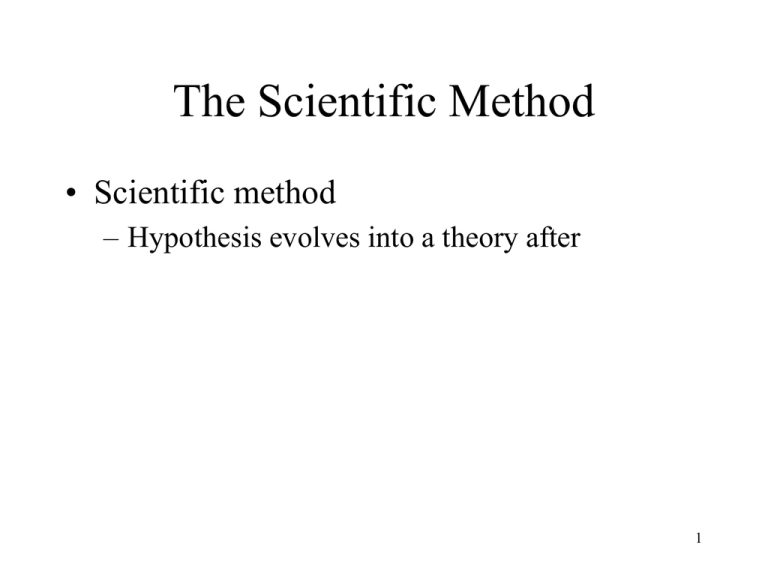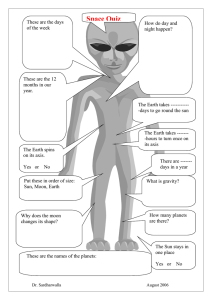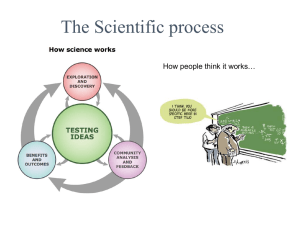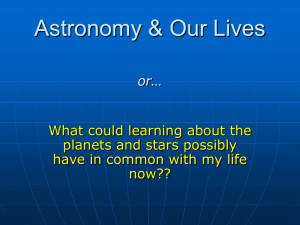The Scientific Method • Scientific method 1
advertisement

The Scientific Method • Scientific method – Hypothesis evolves into a theory after 1 The Scientific Method • Scientific method – Hypothesis evolves into a theory after • Rigorous testing in controlled experiments 2 The Scientific Method • Scientific method – Hypothesis evolves into a theory after • Rigorous testing in controlled experiments • Communicating results to peers 3 The Scientific Method • Scientific method – Hypothesis evolves into a theory after • Rigorous testing in controlled experiments • Communicating results to peers • More testing by independent researchers/teams 4 The Scientific Method • Scientific method – Hypothesis evolves into a theory after • • • • Rigorous testing in controlled experiments Communicating results to peers More testing by independent researchers/teams An accepted theory will be able to make accurate predictions about physical phenomena 5 The Scientific Method • Scientific method – Hypothesis evolves into a theory after • • • • Rigorous testing in controlled experiments Communicating results to peers More testing by independent researchers/teams An accepted theory will be able to make accurate predictions about physical phenomena 6 7 General Relativity Observation Deflection of Stellar Light Path Control Observation: measure star positions outside the Sun’s influence. 8 General Relativity Observation Deflection of Stellar Light Path Prediction: mass of sun warps space, and therefore light paths; stars’ positions will appear to shift 9 General Relativity Observation Deflection of Stellar Light Path Observation that confirms prediction: stars appear to shift position 10 General Relativity Observation Deflection of Stellar Light Path Physical picture 11 General Relativity Observation Deflection of Stellar Light Path Another Control Observation: reduce measurement uncertainties. 12 General Relativity Observation Deflection of GPS Signals • Clock corrections in GPS prevent errors of up to 5 miles/day from accumulating. 13 What is Astronomy? • A branch of science. • Studies the motions, origins, and properties of celestial objects using the scientific method. • Has its origins in ancient history. Crescent Jupiter and Io from Cassini Spacecraft 14 What is Astronomy? • Almost all knowledge is gained through study of light. • Almost always impossible to perform experiments (too far) • Astronomy has made great advances with new technologies. 15 What is Astronomy? • Scientific method – Astronomy is a mostly observational science – Can do only a few controlled experiments in astronomy • Stellar evolution nuclear reactors • Cosmology particle accelerators • Solar System – Send satellites & rovers to planets – Crash probe into comet: Deep Impact Mission – Collect comet matter and return to Earth: Stardust Mission – Can run computer models in place of experiments 16 Origins of Astronomy - Time • The Sun, Moon and stars served humanity for thousands of years as a clock and a calendar. Their motions were predictable. • Today we have other means of measuring time but long ago an accurate understanding of the skies could mean life or death. • Studying the skies told people when to plant and harvest, when to go out to sea, when to expect good or bad weather, etc. 17 Time - Day & Night • How do you know what time it is? • How high is the sun in the sky? • Morning - sunrise • Evening - sunset • Does the Sun really rise and set? Sunrise behind the Space Shuttle 18 Time Day & Night- Earth’s Spin • In reality because the Earth rotates on its axis from West to East the Sun, Moon and stars all appear to move from East to West. • The Sun appears to rise in the East and set in the West because the Earth spins. • The Moon however also orbits the Earth traveling from West to East but it takes much longer than 24 hours to orbit the Earth. However from night to night you can see the Moon change position. 19 Time - The Moon and Months • It takes the Moon about one month to orbit the Earth • Our calendar of months was originally based on the Moon • The word “Month” is derived from the word “Moon” • Jewish and Islamic calendars are still based on the Moon. The New Moon starts a new month. Photograph of crescent Moon and crescent Venus 20 Time - Year and Seasons • Cultures around the world marked the Sun’s yearly motion through the stars. • Summer - Sun is farthest North. • Winter - Sun is farthest South. • Knowing when these dates occurred was very important for agricultural societies First day of Summer at Stonehenge, England 21 Earth’s Orbital Motion • As the Earth orbits the Sun it appears that the Sun is actually moving. • The Sun appears to move through a set of 12 constellations over one year. • Some constellations can only be seen during certain times of year. 22 Earth’s Orbital Motion The path through the sky along which the Sun appears to move is called the ecliptic 23 Earth’s Orbital Motion The other planets appear to follow similar paths near the ecliptic. The band through which the Sun and the planets appear to move is called the Zodiac But the planets really do move! As seen from Earth their motions appear more complicated than they actually are. In fact they sometimes appear to move backwards! This is called retrograde motion. 24


